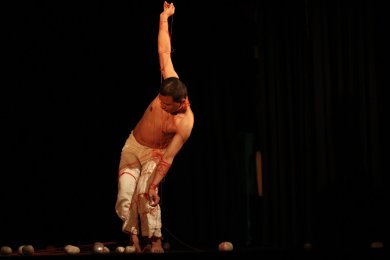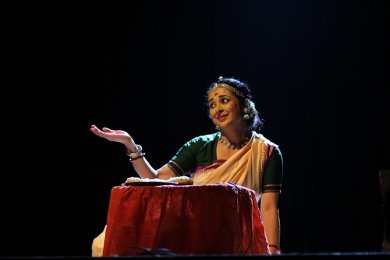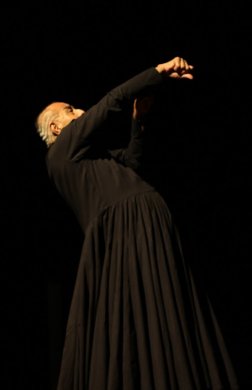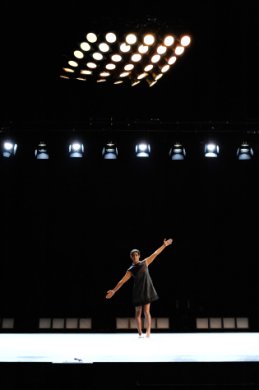
|   |

|   |
Kinetic bodies and the eye of the beholder - Niloshree Bhattacharya e-mail: niloshreeb@gmail.com Photos courtesy: Sapphire Creations March 24, 2018 I am reminded of the sand dunes in Jaisalmer. The sand dunes constantly shift, taking different shapes and forms, and one is always in doubt in a desert; are the sand dunes fluid or solid, how fast or slow are they moving, did time flow at all? The point from where one is looking is crucial because if the location changes, one is struck by a different landscape. It is almost impossible to capture such a constantly shifting landscape in a frame without taking into account one's own location in the desert. Why am I reminded of the desert after attending Samabhavana in Kolkata, a dance conference celebrating the 25th year of Sapphire Creations Dance Company? I was, of course, in awe of some of the performances, but it left me with many questions. I grew up learning the language of Bharatanatyam. In the same way that a child imitates the way of speaking of the parent, I too learnt only to emulate, and, in the process, imbibed a lot more than just the language. From where I am today, as a dancer and a sociologist, I see a landscape in front of me and I am baffled by it. The sheer fluidity of the shifting forms of dance in India and our efforts to frame them in terms such as 'contemporary' and 'classical' is like trying to capture the fluidity of the dunes and fix it in time. Of course, institutionalization of dance forms has contributed towards creating such categories. But I see the emerging dance forms in India as sand dunes, which flow into each other and take emergent shapes constantly, that make us think of the eyes with which we look and think of 'time' and whether it has really passed while we invoke 'newness'. When we think of 'time', we locate it spatially in our memories. The history of dance forms in India, as rightly put by Sadanand Menon in the opening talk of the conference, has been a struggle of memories. Our bodies are archives of the places that have nurtured them and of the encounters which have left a mark, just like the patterns the wind makes on sand dunes. Mitul Sengupta's presentation - based on the intermixing of the languages of Kathak and Classical Jazz techniques - reminded me of my cooking experiments. Why not add some Worcestershire sauce in the Bengali machher jhol and see what it tastes like, or cook avocados and zucchinis with kokam juice? Similar experiments with the forms and languages of any cultural expression have often resulted in creating a hybrid (or fusion) of different styles and some are surprisingly good. But, experiments which play only with 'form' remain merely beautiful or simply different, probably because the messiness of encounters of spatially- and temporally- located memories and the histories and conflicts of the self and the body is hidden. The presentations of Daksha Sheth and Aditi Mangaldas indicated, in different ways, that experiments with form (using techniques of martial arts and yoga with Kathak) can lead to emergent languages. Is it because they blend different 'Indian' forms? Or is it because their experiments move beyond a question of 'form' itself? Or is it because bodies contain histories and ethos of 'places' which limit us and it is only by acknowledging and engaging with such boundaries from within, that innovations can emerge? The performances in Samabhavana introduced me to some such exciting innovations, giving me impressions of the emergent shapes and patterns in the landscape of dance in India. Writing about dance involves translating movements to words.What role does a 'text' about the performance play in interpreting, understanding and translating? I gathered some impressions of the performances in Samabhavana, but, interestingly, the gaps between what I received and what was written made me think: can dance speak for itself? Is dance about a transcendental experience for the performer and the spectator?  Surjit Nongmeikapam  Geeta Chandran Surjit Nongmeikapam's performance - To - minimalist in form and slow in pace, created a fantastic visual imagery by drawing web-like patterns with multiple red threads tied to his body which were attached to stones placed on the stage. He effortlessly portrayed a sense of heaviness associated with the loss of loved ones. For me, the stones were metaphors for weight and the red threads signified blood. Looking through the context of Manipur, he moved from the 'particular' to the abstract and it made me think of other places, like Kashmir. Geeta Chandran's piece, titled Unurth, established that stage lighting can do wonders for the visual experience but to make sense of it, I had to read the written text which says 'no meaning might not always be meaningless.'  Sharmila Biswas  Hemabharathy Palani Sharmila Biswas's piece Evoking Radha showed a woman who imagines Radha in her mundane life. The piece was multi-layered; juxtaposing mundane realities and fantasies about love with beautifully portrayed eroticism where myths, everyday life, and performance intertwined with each other. By clearly demarcating two characters, the ordinary woman and Radha, she compelled me to think of them through her eyes, and I relished the shringar rasa. Interestingly, Hemabharathy Palani's piece Yashti builds upon a similar theme of women's sexuality, but through a different language. With a fast pace and constantly shifting imagery built on metaphors of the body, inspired by the poems of Andal and Akka Mahadevi, she left me uneasy. Had I not read the text about her performance later, I would have remembered it as a jumble of grotesque and bizarre movements, portraying the angry and 'exploited' woman trying to make a raw statement about her sexuality.  Astad Deboo  Padmini Chettur Astad Deboo, in his piece Liminal, used minimal movements and explored themes of disparity, anxiety and depression. It took me on a journey where I did not know when I had transcended to a realm in which the visual form, personal identification with such emotions, and the emotions as abstract 'objects' existed with each other. Padmini Chettur critically engaged with some basic concepts such as the body, the space and movement in her piece Beautiful Thing 2. She left me with one question; was it supposed to be a conversation with the self or a performance? Critical engagements with such concepts are essential and thought provoking. But is that an end in itself or a means to an end? The multiplicity of 'meanings' with no defined closure seems to be one emergent pattern, indicating postmodern elements in the landscape of dance today. Isn't there a difference between 'no meaning' and 'many meanings'? Dance must speak for itself, allowing it to be 'read' in many ways. This may happen when a performance moves from the particular to the abstract, can be minimal and yet speak volumes, can be multilayered and metaphoric, and, above all, can evoke rasa irrespective of the form and language. Two overlapping yet distinct ideas about the 'end' or 'purpose' of dance exist - a transcendental experience and representations of realities - which are often juxtaposed against each other, superimposed onto other categories. Rather, these are not two different 'ends', but two ends of the same thread. Again, it is about the end from which we are looking. Niloshree Bhattacharya is trained in Bharatanatyam and is Assistant Professor in Sociology in Presidency University, Kolkata. |